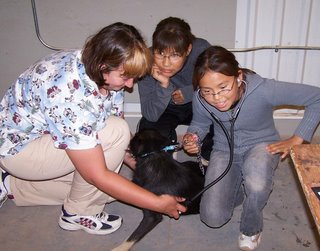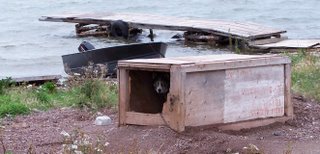
Letter from Lutsel K'e.
What an amazing trip! I'd like first to give a HUGE thank you to our sponsors that made this trip both financially and organizationally possible. There were a few people that put in so much hard work for us and for this we are very grateful.
Our group of four C.A.A.T. members; veterinarian Ken, technician Jennifer, and amazing assistants Corinne and Steve, spent six days in the community of Lutsel K'e. This is a community of the Dene native tribe on the shore of Great Slave Lake. The community contains 300-450 people (depending on who you ask) of which, approximately 1/3 are children. Lutsel K'e has a school (kindergarten to grade 10), a community hall, a new arena, a fire hall, a four bedroom seniors housing complex, a CO-OP store, a church, an RCMP office, the nursing station (where we were housed), and various houses. And of course, many dogs.
 The one hour flight to Lutsel K'e from Yellowknife gave us a great opportunity to see the landscape up close. The rocky terrain has been carved by glacier movement and there are areas where the rock looks like waves. The flora consists mainly of spindly trees and muskeg. There's yellow lichen that grows quite prolifically.
The one hour flight to Lutsel K'e from Yellowknife gave us a great opportunity to see the landscape up close. The rocky terrain has been carved by glacier movement and there are areas where the rock looks like waves. The flora consists mainly of spindly trees and muskeg. There's yellow lichen that grows quite prolifically. The fire hall became our 'clinic'. We set up shop and had our first patient at 3pm - "Myah" whose mom was a Springer spaniel and whose dad was a black Lab. Our clippers did not work at all; this was so frustrating and time consuming having to scissor then cut the hair with a disposable shaving blade.
 The breeds of the dogs up North aren't what we expected. We had packed for mainly large Husky size dogs. The majority of dogs we saw were less than 40 lbs. What surprised me was the number of 'Wild Shih tzus of the North'. Unfortunately, their hair coats are not conducive to the climate and we saw many Shih tzus who were badly matted and had burrs and grass awns stuck to them.
The breeds of the dogs up North aren't what we expected. We had packed for mainly large Husky size dogs. The majority of dogs we saw were less than 40 lbs. What surprised me was the number of 'Wild Shih tzus of the North'. Unfortunately, their hair coats are not conducive to the climate and we saw many Shih tzus who were badly matted and had burrs and grass awns stuck to them.We were told that dogs at one time served a great purpose in Lutsel K'e. They were used for transportation and survival. Unfortunately, with the majority of people relying now on their ATVs and snowmobiles, the dogs have seemed to become a possession instead of a valued part of the family unit. We saw many dogs that were tied up at all times with no access to fresh water.

A few old traditions still remain. One of these is Dog Island. During the summer months when the ice is off the lake, a small group of community members keep their dogs on a few of the smaller close-by islands. When the lake water freezes enough, the dogs are returned to the village. I believe I'm remembering correctly to say that by doing this keeps the dogs in shape by allowing them to roam free on the island instead of being tied up in town. We were taken on a boat tour by Constable Brent and his fiancé Sherry. We went past one of the dog islands. We could see two male dogs tied up to a cable, an untied bitch and five puppies. I'm not sure why the males were tied up. It seems to contradict the purpose of dog island if the dogs aren't allowed to roam free.

Most of our surgeries were done in the first three days. In total we neutered twenty males, spayed seventeen females and vaccinated/dewormed sixty-four dogs and one cat. Our anesthetics went smoothly for the most part. All the dogs, except the few that Nurse Sheryl had already inoculated, were vaccinated against Distemper, Parvovirus, Rabies, Hepatitis and Parainfluenza as well as dewormed and given an application of Advantage. Every animal we operated on had a bright yellow ear tag placed in their right ear. It was neat to see the ear tags in the dogs around the village after a few days. It made me feel like we were doing something worthwhile. The puppies that had surgery were bouncing around the next day - so much for the strict rest home care recommendations!
Most of the dogs were thin but not too thin. A few of the house dogs (while most were outside dogs there were a few dogs that lived inside the houses) were even chunky! It is much too expensive for most people to be able to ship in kibble dog food. I saw dogs eating mostly leftovers, wild game and fish. The teeth on the younger dogs were mainly tartar free. We didn't see much gingivitis. However, I did see an interesting pinkish discolouration to the enamel on quite a few dogs. Many of the older dogs had tartar, loose teeth, or chipped teeth. Most of the dogs had clean ear canals as well, except where the ever-present flies had bitten the ears along the edges and one old lab that looked to have a chronic ear infection. The skin appeared dry and flakey on a lot of the dogs, where as the fur coats were soft and thick. We didn't see any signs of external parasites other than the fly bitten ears.
We were able to enjoy some fishing in the Snowdrift River which runs along one side of the community. Among the fish caught were a Northern Pike and a 10-11 lb trout that Corinne snagged on her line. We were using a little fish called a Cisco as bait.
The Dene language has a few interesting letters in its alphabet. I don't see any on my keyboard but I'll describe a few. There's a letter that is the top part minus the period of the question mark ( ? ). I didn't find out what sound it made. There are the letters o, d, and g that have horizontal lines through them. Marci cho means thank you. Sa is the word for sun and eenaa is the word for mother.
We popped into the CO-OP store a few times as it was the only place that had a bank machine. I jotted down a few of the prices. $8.00 for a 2 L. carton of milk. $9.89 for 950 mls of Mayonnaise. $3.39 for a can of French style green beans. $9.99 for a 1.36L can of tomato juice. $6.99 for a 1kg bag of frozen green beans. $5.49 for a 950ml bottle of Sunlight dish soap. Needless to say groceries are very expensive on the whole! Nurse Sheryl said she felt diabetes would be a big problem in about ten years as the people are moving away from the traditional lifestyle of eating and exercise. In such a small town, it amazes me how many people ride on their ATVs to go such a short distance. A few people have their groceries flown in from Yellowknife. But at $1 a lb for freight and a 5% packing fee on top of the price of the groceries it still makes food and supplies expensive. Once a year a large barge ships in a lot of the bigger items (i.e. building materials and furniture) and supplies.
Lutsel K'e has an amazing artist by the name of John Rombough. I really liked his artwork and was so appreciative that he stopped by the clinic one day to show us some of his wares. Three of us are now the proud owners of a piece of John's artwork. Nurse Sheryl makes another kind of artwork she calls fish scale art. She dyes then dries fish scales and glues them onto rocks, wood, and bones in the shapes of flowers.
One of the highlights for us carnivores was a meal cooked by Nurse Brenda. We had caribou meat in an onion sauce along with the wild shaggy mane mushrooms we picked on the village outskirts. Caribou meat is so tender and mild tasting. Yum yum! Nurse Brenda said a lot of the people in the community boil their meat and fish. Corinne and I also got to taste fire-cooked fish eggs. There are teepees around the village used to dry meat and fish.

Lutsel K'e has dog shooting days. The people are given a days notice to keep their dogs tied up. On dog shooting day, any dog found at large is shot. There is a $50 bounty on each of the dogs shot. I hope that our yellow tagged dogs will be exempt from being shot. We tried to tell people that the tags meant that these dogs have been spayed/neutered and that other than a reason of a behavior problem these tagged dogs shouldn't be shot. I understand that dog shooting days are a financially economical way to deal with the large dog population problem. However, we heard stories of wonderful friendly dogs getting shot. Another area that needs addressing is the behaviour of the children around the dogs. This would be a great educational service for the community for the next group going to Lutsel K'e to try and initiate.
 I think our entire group had their eyes opened to another part of huge and wonderful country. I can only express my own excitement of the trip but I think it would be shared by all in our group. Lutsel K'e is an amazing land and the Dene people are an amazing people. I hope we were able to plant a few seeds that will grow into a solution for the dog problem in Lutsel K'e.
I think our entire group had their eyes opened to another part of huge and wonderful country. I can only express my own excitement of the trip but I think it would be shared by all in our group. Lutsel K'e is an amazing land and the Dene people are an amazing people. I hope we were able to plant a few seeds that will grow into a solution for the dog problem in Lutsel K'e. Lastly a special thank you to the owners of the following dogs. You trusted a group of white strangers with your dogs and I hope you know how thankful we are to be given the responsibility to help you with your dog problem. Without your participation, our project wouldn't have been the success it was. Myah, Zeus, Browny, Scruffy, Duke, Memphis, Weasel, Airhaw, Angel, Sleepy, Winter, Tolson, Socks, Trigger, Cheeta, Spike, Nuts, Tess, Dakota, Candy, Garfield (the cat), Melody, Dodger, Chub Chubs, Princess, Penny, Sacho, Sasha, Rex, Butch, Scooter, Killer, Lucky, Otis, Shadow, Delgah, Puppy, Boxer, Champ, Whitey, Beethoven, Raven, Spark, Melo, Gizmo, and the many unnamed puppies.
- Jennifer Rabie, Registered Animal Health Technologist, Summerland, BC

1 comment:
hey your blog design is very nice, clean and fresh and with updated content, make people feel peace and I always like browsing your site.
- Norman
Post a Comment